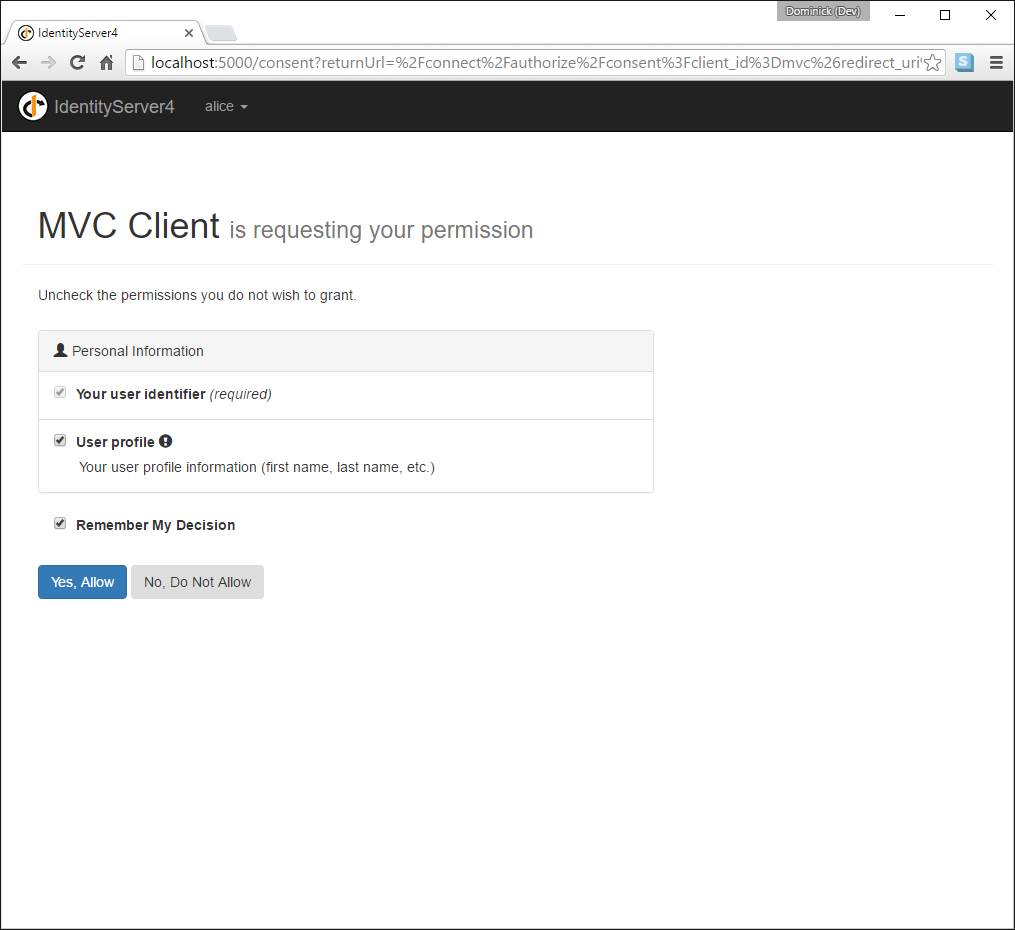利用OpenID Connect添加用户认证
利用OpenID Connect添加用户认证
在这个示例中我们想要通过OpenID Connect协议将交互用户添加到我们的IdentityServer上面。
准备就绪后,我们会创建一个MVC的应用来使用IdentityServer做认证。
添加UI
关于该协议支持所需要的一切都内建到了IdentityServer中,你需要为登陆、登出、确认和错误等提供必要的UI页面。
虽然在每一个实现了IdentityServer的服务中它所实现的外观和工作流程等都是不一样的,我们提供了一个MVC模板,你可以将其作为起点。
可以从 Quickstart UI repo找到这个示例。你可以(使用github)克隆或者下载到你的桌面然后将控制器、视图、模型和Css样式表等放到你的应用里面。
你也可以在你的项目的根目录下面运行下面这个命令行(在powershell)进行自动的安装:
iex ((New-Object System.Net.WebClient).DownloadString('https://raw.githubusercontent.com/IdentityServer/IdentityServer4.Quickstart.UI/release/get.ps1'))
一点你安装好了这些之后,你也需要在Startup类中配置好你的MVC,这需要在ConfigureService里面将MVC添加到DI中并在Configure方法中将MVC中间件添加到管道上。
public void ConfigureServices(IServiceCollection services) { services.AddMvc(); // configure identity server with in-memory stores, keys, clients and scopes services.AddIdentityServer() .AddDeveloperSigningCredential() .AddInMemoryApiResources(Config.GetApiResources()) .AddInMemoryClients(Config.GetClients()) .AddTestUsers(Config.GetUsers()); }
并且应该将MVC作为管道的最后一个中间件:
public void Configure(IApplicationBuilder app, IHostingEnvironment env) { if (env.IsDevelopment()) { app.UseDeveloperExceptionPage(); } app.UseIdentityServer(); app.UseStaticFiles(); app.UseMvcWithDefaultRoute(); }
从readme可以看到更多的信息。
花费一些时间检查以下控制器和模型,你越了解他们,在后续的升级和改造过程中也会越容易。大多数代码都保存在一个QuickStart的文件夹中。如果这种方式不适合你的话,你可以自己修改成你要的风格。
创建一个MVC客户端
下一步你得创建一个MVC的应用。使用Asp.net core自带的模板就可以。不要配置认证信息。关于认证的信息需要你在应用里面自己配置。一旦你创建好应用后,将应用的端口号配置到5002上面。
为了添加对OpenID Connect认证的支持,需要在Startup类中的ConfigureService方法中进行如下的配置。
public void ConfigureServices(IServiceCollection services) { services.AddMvc(); JwtSecurityTokenHandler.DefaultInboundClaimTypeMap.Clear(); services.AddAuthentication(options => { options.DefaultScheme = "Cookies"; options.DefaultChallengeScheme = "oidc"; }) .AddCookie("Cookies") .AddOpenIdConnect("oidc", options => { options.SignInScheme = "Cookies"; options.Authority = "http://localhost:5000"; options.RequireHttpsMetadata = false; options.ClientId = "mvc"; options.SaveTokens = true; }); }
AddAuthentication 方法将认证服务添加到了DI系统中,我们使用了一个cookie作为认证用户的主要手段(通过options.DefaultScheme=“Cookies”来指定)。我们将DefaultChallengeScheme设置成“oidc”使用为当我们需要用户登陆的时候,我们要使用OpenID Connect的scheme。
然后我们使用AddCookie方法添加一个对应的处理Cookie的handler(对应于options.DefaultScheme=“”Cookies“这个配置)。
最后,AddOpenIdConnect方法配置了相应的handler(对应于options.DefaultChallengeScheme=”oidc”)来执行OpenID Connect协议。Authority指定了我们要新人的IdentityServer;然后通过ClientId标志了客户端;SiginScheme=“Cookies“这个表示当OpenId Connect协议执行完成之后会使用cookie handler来发布cookie。
此外,我们关闭了JWT claim的类型映射以允许OpenId Connect中的claim类型。
JwtSecurityTokenHandler.DefaultInboundClaimTypeMap.Clear();
然后为了认证服务会在每个请求中都执行,需要在Startup类中的Configure方法中配置认证的中间件:
public void Configure(IApplicationBuilder app, IHostingEnvironment env) { if (env.IsDevelopment()) { app.UseDeveloperExceptionPage(); } else { app.UseExceptionHandler("/Home/Error"); } app.UseAuthentication(); app.UseStaticFiles(); app.UseMvcWithDefaultRoute(); }
认证中间件应该放在MVC的前面。
最后一步是要触发认证。我们需要在home控制器上面添加[Autorize]特性。同时修改一下about页面:
<dl> @foreach (var claim in User.Claims) { <dt>@claim.Type</dt> <dd>@claim.Value</dd> } </dl>
如果你现在使用浏览器访问了刚才配置好的控制器的路径,那么会有一个重定向发送到IdentityServer。这回导致一个错误因为MVC客户端还没有注册到Identityserver。
添加对OpenID Connect Identity Scopes的支持
和OAuth2.0相似的是,OpenID Connect同样使用了scopes这个概念。再一次声明:scopes代表了你想要保护的,同时,也是客户端想要访问的那种东西。与OAuth对比一下,scopes在OIDC中并不代表APIs,而是代表了用户的数据,比如user id、name或者email等。
在这里阐述一下:scopes在OIDC里面是和claim挂钩的,他们之间的关系是1对多。打个比方,profile里面包含了许多的claim,包括first_name last_name等等。。
在Config类中添加一个帮助方法,这个方法创建了一个IdentityResource的集合,它添加了对标准openid(subject id)和profile(用户的名、姓等等)scopes的支持。
public static IEnumerable<IdentityResource> GetIdentityResources() { return new List<IdentityResource> { new IdentityResources.OpenId(), new IdentityResources.Profile(), }; }
所有标准scopes对应的claims都能在specification找到。
然后你得将上面配置好的添加到ConfgureService方法中,使用AddInmemoryIdentityResource:
public void ConfigureServices(IServiceCollection services) { services.AddMvc(); // configure identity server with in-memory stores, keys, clients and scopes services.AddIdentityServer() .AddDeveloperSigningCredential() .AddInMemoryIdentityResources(Config.GetIdentityResources()) .AddInMemoryApiResources(Config.GetApiResources()) .AddInMemoryClients(Config.GetClients()) .AddTestUsers(Config.GetUsers()); }
添加一个客户端用于演示OpenID Connect的隐式流程
最后一步是在IdentityServer中为MVC客户端添加一个新的入口。
在IdentitySErver中配置基于OpenId Connect的客户端和配置OAuth2.0的客户端有些相似。但是因为在OpenID Connect中经常会有交互发生,所有我们需要在配置中添加一写重定向。
在客户端配置的代码中写入如下:
public static IEnumerable<Client> GetClients() { return new List<Client> { // other clients omitted... // OpenID Connect implicit flow client (MVC) new Client { ClientId = "mvc", ClientName = "MVC Client", AllowedGrantTypes = GrantTypes.Implicit, // where to redirect to after login RedirectUris = { "http://localhost:5002/signin-oidc" }, // where to redirect to after logout PostLogoutRedirectUris = { "http://localhost:5002/signout-callback-oidc" }, AllowedScopes = new List<string> { IdentityServerConstants.StandardScopes.OpenId, IdentityServerConstants.StandardScopes.Profile } } }; }
测试客户端
现在终于都办妥了。
导航到被保护的控制器上以便触发认证,这时你会发现被重定向到了IdentitySErver上的登陆页面:

登陆成功后,会给用户呈现一个确认页面。在这里用户可以决定他是否要将一些访问资源的权限交给客户端。
确认页面可以在配置中的RequireConsent属性上取消。

最终页面会跳转到客户端应用上,展示用户的claim。

添加登出
在添加一个登出的功能吧。
使用像identity server这样的身份验证服务,只需要清除本地应用程序cookie就不够了。此外,你还需要对身份服务器进行一次往返,以清除中心单点登录会话。
确切的协议步骤是在OpenID Connect中间件中实现的,只需将以下代码添加到某个控制器中以触发信号:
public async Task Logout() { await HttpContext.SignOutAsync("Cookies"); await HttpContext.SignOutAsync("oidc"); }
这将会清除本地的cookie然后重定向到Identityserver。Identtiyserver会清除它的Cookie然后给用户一个返回MVC应用的链接。
进一步的尝试
就像上面提到的,OpenId Connect中间件默认会请求profile scope。这个scope中包含了诸如name website等claim。
将这些claim添加到TestUser上面,这样一来IdentityServer可以将他们放到Id token里面:
public static List<TestUser> GetUsers() { return new List<TestUser> { new TestUser { SubjectId = "1", Username = "alice", Password = "password", Claims = new [] { new Claim("name", "Alice"), new Claim("website", "https://alice.com") } }, new TestUser { SubjectId = "2", Username = "bob", Password = "password", Claims = new [] { new Claim("name", "Bob"), new Claim("website", "https://bob.com") } } }; }
下一次你再认证的时候,你的展示claims的页面就会展示这些额外的claim了。
试着任意添加一些claim,或者更多的scopes。在OpenId Connect中间件中的Scope属性上面进行的配置会决定你发送到IdentityServer的认证请求中会包含那些scopes:
services.AddAuthentication(option => { option.DefaultScheme = "cookies"; option.DefaultChallengeScheme = "oidc"; }).AddCookie("cookies").AddOpenIdConnect("oidc", option => { option.Scope.Add("somescope");//这句 });
同样值得注意的是,检索令牌的claim是一个可扩展点----IProfileService。因为我们使用AddTestUsers,TestUserProfileService是默认被使用的。你可以检查源代码here 来看看它是如何工作的。